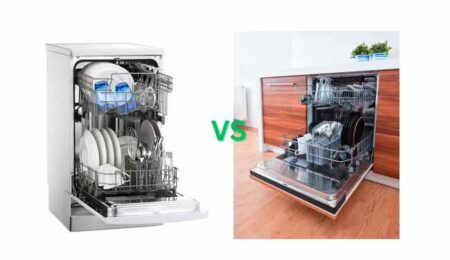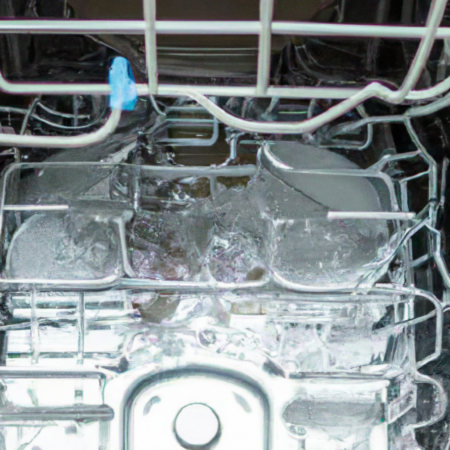The Invention of the First Dishwasher
In 1886, Josephine Cochrane invented the first dishwasher. She was tired of her fine china being chipped during manual dishwashing by her servants. This frustration led her to develop a mechanical dishwashing machine that would handle her dishes with care. Her invention revolutionized the way we wash dishes today.
Early Dishwashing Machines
Cochrane’s first dishwasher used a hand-operated wooden wheel that held wire compartments for dishes. It sprayed hot, soapy water using water pressure, effectively cleaning the dishes. This early dishwasher would run without the need for manual washing. Dishwashing machines like these were primarily used in commercial dishwashing settings, such as hotels and restaurants.
Evolution to Automatic Dishwashing
Over time, dishwasher technology evolved, leading to the development of the automatic dishwasher. These modern dishwashers often included features like detergent dispensers, rinse aid, and timers. This shift from manual to automatic dishwashing helped save energy and water, making them more efficient and environmentally friendly.
Energy Efficiency and Water Consumption
One of the significant advantages of using a dishwasher over manual dishwashing is the reduction in energy and water consumption. Dishwashers use less water and energy than washing dishes by hand, as they can clean a large capacity of dishes with a single cycle. Additionally, energy-efficient automatic dishwashers are designed to optimize energy use, further reducing energy consumption.
The Role of Detergent and Rinse Aid
Dishwasher detergent plays a crucial role in the dishwashing process. It helps break down food particles, making it easier for the dishwasher to clean dirty dishes. Rinse aid, on the other hand, helps reduce water spots and ensures that dishes dry faster. Both dishwasher detergent and rinse aid contribute to the overall effectiveness and efficiency of the dishwashing process.
Types of Dishwashers
There are various types of dishwashers available in the market. Some common types include built-in, portable, drawer dishwasher, and countertop models. Each variant of the dishwasher caters to different needs and preferences.
Built-in dishwashers are the most common type, usually installed under a kitchen counter. Portable dishwashers can be moved around and connected to a faucet when needed. Drawer dishwashers have multiple compartments, allowing users to wash small loads independently. Countertop models are compact and perfect for small kitchens or apartments with limited space.
Inside the Dishwasher
The inside of a dishwasher consists of racks, typically one on the top and one on the bottom of the dishwasher. These racks hold dishes, pots, and pans securely during the washing process. Some dishwashers have unique features, such as adjustable racks or a back wall of the dishwasher that directs water, allowing for more efficient and thorough cleaning.
The dishwasher door plays a critical role in keeping water and energy contained during the wash cycle. It also helps prevent leaks and spills. Some dishwashers have a service kickplate beneath the dishwasher door that allows for easy maintenance and access to internal components.
Hot Water in a Dishwasher
Hot water is essential for effective dishwashing, as it helps dissolve and remove food particles from dirty dishes. Most dishwashers heat the water to a specific temperature to ensure optimal cleaning. This high temperature also aids in sanitizing the dishes, making them safe to use.
Dishwasher Manufacturers and Models
There are numerous dishwasher manufacturers, each offering a range of models with different features and specifications. When buying a dishwasher, consumers should consider factors like capacity, energy efficiency, noise level, and special features to find the best fit for their needs.
Tips for Using a Dishwasher
To make the most of your dishwasher, follow these simple tips:
- Load your dishes properly: Place larger items like pots and pans on the bottom rack, and smaller items like cups and glasses on the top rack. Be sure not to overcrowd the dishwasher, as this can prevent proper cleaning.
- Scrape off large food particles: While it’s not necessary to pre-rinse your dishes, removing large food particles can help prevent clogs and ensure a more thorough cleaning.
- Use the right detergent and rinse aid: Choose a high-quality dishwasher detergent and rinse aid for the best results. Be sure to follow the manufacturer’s recommendations for detergent use.
- Run full loads: To save water and energy, try to run your dishwasher with a full load of dishes. This way, you’ll maximize the energy and water consumption efficiency.
- Clean the dishwasher regularly: To maintain your dishwasher’s performance, clean the interior, filter, and spray arms periodically. This will help prevent buildup and ensure that your dishwasher works efficiently.
- Choose the right cycle: Modern dishwashers often have multiple wash cycles for different levels of cleaning. Be sure to select the appropriate cycle for your dishes to achieve the best results.
Energy Star Certified Dishwashers
Energy Star certified dishwashers are designed to be more energy-efficient and environmentally friendly than non-certified models. These dishwashers use less water and energy, reducing their impact on the environment and helping users save on utility bills.
Manual Dishwashing Habits vs. Using a Dishwasher
While some people still prefer manual dishwashing, using a dishwasher has several advantages. Dishwashers save time, energy, and water, and provide a more hygienic cleaning method due to higher water temperatures. Additionally, using a dishwasher can reduce the risk of chipping or breaking delicate dishes.
In conclusion, the evolution of dishwasher technology has come a long way since Josephine Cochrane’s first invention in 1886. Modern dishwashers offer a wide range of features and benefits, making them an essential appliance in many households. By understanding the history and development of dishwashers, users can better appreciate the convenience and efficiency they bring to our daily lives.
Frequently Asked Questions (FAQ)
Q: Who invented the first dishwasher?
A: Josephine Cochrane invented the first dishwasher in 1886 to protect her fine china from chipping during manual dishwashing.
Q: How do dishwashers save water and energy compared to manual dishwashing?
A: Dishwashers use less water and energy by cleaning a large capacity of dishes in a single cycle, and they also have optimized energy use through features like temperature control and timers. Energy Star certified dishwashers are designed to be even more energy-efficient and environmentally friendly.
Q: What are the different types of dishwashers available?
A: Some common types of dishwashers include built-in, portable, drawer, and countertop models. Each type caters to different needs and preferences based on factors such as space, portability, and capacity.
Q: How do I properly load a dishwasher?
A: Place larger items like pots and pans on the bottom rack and smaller items like cups and glasses on the top rack. Avoid overcrowding the dishwasher to ensure proper cleaning.
Q: Do I need to pre-rinse dishes before loading them into the dishwasher?
A: While it’s not necessary to pre-rinse your dishes, it’s a good idea to scrape off large food particles to prevent clogs and ensure a more thorough cleaning.
Q: What is the role of dishwasher detergent and rinse aid?
A: Dishwasher detergent helps break down food particles, making it easier for the dishwasher to clean dirty dishes. Rinse aid reduces water spots and ensures that dishes dry faster. Both contribute to the overall effectiveness and efficiency of the dishwashing process.
Q: How do I maintain my dishwasher for optimal performance?
A: Clean the dishwasher’s interior, filter, and spray arms regularly to prevent buildup and ensure that it works efficiently. Also, follow the manufacturer’s recommendations for detergent use and maintenance.
Q: What should I consider when buying a dishwasher?
A: When buying a dishwasher, consider factors like capacity, energy efficiency, noise level, and special features to find the best fit for your needs.

















